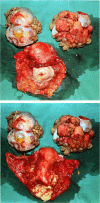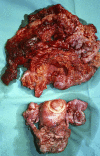Advanced Ovarian Cancer: Primary or Interval Debulking? Five Categories of Patients in View of the Results of Randomized Trials and Tumor Biology: Primary Debulking Surgery and Interval Debulking Surgery for Advanced Ovarian Cancer
- PMID: 27009938
- PMCID: PMC4912357
- DOI: 10.1634/theoncologist.2015-0239
Advanced Ovarian Cancer: Primary or Interval Debulking? Five Categories of Patients in View of the Results of Randomized Trials and Tumor Biology: Primary Debulking Surgery and Interval Debulking Surgery for Advanced Ovarian Cancer
Abstract
Background: Standard treatment of stage III and IV advanced ovarian cancer (AOC) consists of primary debulking surgery (PDS) followed by chemotherapy. Since the publication of the European Organisation for Research and Treatment of Cancer/National Cancer Institute of Canada trial, clinical practice has changed and many AOC patients are now treated with neoadjuvant chemotherapy (NACT) followed by interval debulking surgery (IDS). The best option remains unclear. Ovarian cancer is a heterogenic disease. Should we use the diversity in biology of the tumor and patterns of tumor localization to better stratify patients between both approaches?
Methods: This analysis was based on results of five phase III randomized controlled trials on PDS and IDS in AOC patients, three Cochrane reviews, and four meta-analyses.
Results: There is still no evidence that NACT-IDS is superior to PDS. Clinical status, tumor biology, and chemosensitivity should be taken into account to individualize surgical approach. Nonserous (type 1) tumors with favorable prognosis are less chemosensitive, and omitting optimal PDS will lead to less favorable outcome. For patients with advanced serous ovarian cancer (type 2) associated with severe comorbidity or low performance status, NACT-IDS is the preferred option.
Conclusion: We propose stratifying AOC patients into five categories according to patterns of tumor spread (reflecting the biologic behavior), response to chemotherapy, and prognosis to make a more rational decision between PDS and NACT-IDS.
Implications for practice: Trial results regarding effect and timing of debulking surgery on survival of patients with advanced ovarian cancer have been inconsistent and hence difficult to interpret. This review examines all randomized trials on primary and interval debulking surgery in advanced ovarian cancer, including the results of the newly published CHORUS (chemotherapy or upfront surgery for newly diagnosed advanced ovarian cancer) trial. On the basis of findings presented in this review and in view of recent molecular data on the heterogeneity of ovarian tumors, we propose prognostic categorization for patients with advanced ovarian cancer to better distinguish those who would optimally benefit from primary debulking from those who would better benefit from interval debulking following neoadjuvant chemotherapy.
Keywords: Categories; Debulking; Ovarian cancer, type 1 and 2; Randomized trials; Stage III–IV.
©AlphaMed Press.
Conflict of interest statement
Disclosures of potential conflicts of interest may be found at the end of this article.
Figures




References
-
- Chen LM, Berek JS. Epithelial carcinoma of the ovary, fallopian tube, and peritoneum: Epidemiology and risk factors. UpToDate. 2015 . http://www.uptodate.com. Accessed June 15, 2015.
-
- Heintz AP, Odicino F, Maisonneuve P, et al. Carcinoma of the ovary. FIGO 26th Annual Report on the Results of Treatment in Gynecological Cancer. Int J Gynaecol Obstet. 2006;95(suppl 1):S161–S192. - PubMed
-
- Prat J. New insights into ovarian cancer pathology. Ann Oncol. 2012;23(suppl 10):x111–x117. - PubMed
-
- Redman CW, Warwick J, Luesley DM, et al. Intervention debulking surgery in advanced epithelial ovarian cancer. Br J Obstet Gynaecol. 1994;101:142–146. - PubMed
Publication types
MeSH terms
Substances
LinkOut - more resources
Full Text Sources
Other Literature Sources
Medical
Miscellaneous

